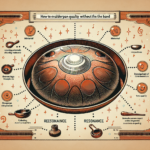<!DOCTYPE html>
<html lang="en">
<head>
<meta charset="UTF-8">
<meta name="viewport" content="width=device-width, initial-scale=1.0">
<title>Melodies in Metal: The Development and Popularization of the Handpan</title>
<style>
body {
font-family: Arial, sans-serif;
margin: 20px;
line-height: 1.6;
color: #333;
}
h1, h2, h3 {
color: #1565C0;
}
</style>
</head>
<body>
<h1>Melodies in Metal: The Development and Popularization of the Handpan</h1>
<p>The handpan is a unique and charming musical instrument that has captured the imagination of musicians and enthusiasts around the world. Known for its ethereal sound and beautiful craftsmanship, the handpan is a relatively new entrant to the world of music. Despite its youth, its resonance has echoed across global stages, creating a significant impact in a short span. This article delves into the development of this fascinating instrument and how it has become a beloved tool for musical exploration and expression.</p>
<h2>The Birth of the Handpan</h2>
<p>The story of the handpan begins with the Hang, an instrument crafted by Swiss company PANArt in the year 2000. Felix Rohner and Sabina Schärer, the founders of PANArt, drew inspiration from the Trinidadian steelpan and the Indian ghatam when designing the Hang. Blending traditional techniques with innovative ideas, they created an instrument shaped like a flying saucer, consisting of two metal half-shells glued together with a cavity inside, allowing for a melodic, resonant sound.</p>
<p>Initially, the Hang was intended as a limited-production item. PANArt limited its distribution, only selling to those they deemed committed to exploring the depth of its sound. However, the uniqueness and musical allure of the Hang soon captured worldwide attention, sparking interest and intrigue among musicians and instrument makers outside Switzerland.</p>
<h2>Evolution and Diversification</h2>
<p>As the Hang's popularity grew, so did the demand for similar instruments. In response, various craftsmen around the world began developing their own versions. These new instruments retained the unique UFO-like shape and metallic tonality of the original but were often adapted further to suit diverse musical traditions and preferences. This broader category of instruments came to be known collectively as "handpans."</p>
<p>Handpan makers expanded upon the original design, experimenting with different types of metal, tuning scales, and methods of crafting. While the core principles of the handpan's creation remained consistent – creating a melodic, harmonious sound by manipulating metal – each maker brought their own innovations and regional influences to the instrument. This diversification led to an explosion of new musical possibilities accessible to players worldwide.</p>
<h2>Popularity and Cultural Impact</h2>
<p>By the mid-2000s, the handpan had begun its ascension to global recognition. This was fueled by the internet's growing influence on music distribution and sharing. Musicians readily shared their performances on platforms like YouTube, igniting the curiosity of seasoned artists and budding enthusiasts alike. The handpan's calming and meditative sound found a fitting context in yoga studios, healing retreats, and concert halls, enhancing its appeal to audiences seeking novel auditory experiences.</p>
<p>One of the pivotal moments in the handpan's popularization was its embrace by street musicians. Its compact and portable nature made it ideal for busking and live performances in unconventional spaces. This exposure, coupled with its captivating sound, helped the handpan transcend geographical and cultural boundaries. As a result, it became more than merely a musical instrument; it evolved into a medium for cultural exchange, connecting people through the universal language of music.</p>
<h2>Modern Variants and Innovations</h2>
<p>The current landscape of the handpan world is rich with innovation and creativity. Makers continue to push boundaries, experimenting with varied shapes, sizes, and acoustic properties. Some have introduced hybrid versions, merging electronic elements with traditional handpan design to expand its sonic range. These modern variants are increasingly flexible, allowing musicians to explore genres beyond traditional or ambient music, including pop, electronic, and even orchestral compositions.</p>
<p>Another noteworthy innovation is the development of accessible and affordable handpans for beginners. As demand soared, some manufacturers tailored their offerings to accommodate beginners, providing instruments at more economical price points without compromising on quality. This inclusivity has significantly broadened the handpan's appeal, making it attainable for a larger audience and ensuring its continuing growth and evolution.</p>
<h2>Handpan Communities and Collaboration</h2>
<p>The handpan's rise has also been supported by the development of a vibrant global community. Enthusiasts, musicians, and makers gather at festivals, workshops, and online forums to share their passion, exchange techniques, and collaborate on projects. These communities have become crucial in sustaining the handpan's legacy, offering both an emotional and technical support network for newcomers and seasoned players alike.</p>
<p>Within these communities, collaboration is a cornerstone. Musicians often collaborate with other instrumentalists and producers, creating unique fusions that expand the handpan's role in contemporary music. These collaborations have paved the way for innovative projects, integrating handpan sounds into diverse musical genres and multimedia art forms, enriching its cultural tapestry.</p>
<h2>Conclusion</h2>
<p>From its origins as the pioneering Hang to its current status as a globally celebrated instrument, the handpan has undergone a remarkable journey. Its development and popularization are a testament to the power of innovation, community, and the universal language of music. As it continues to evolve, the handpan promises to inspire creativity and connection across generations, breaking down barriers through its enchanting melodies and harmonious resonance. The growth of handpans not only signifies the ever-expanding world of music but also stands as a beacon of the unity that music can bring in an increasingly interconnected world.</p>
<h2>FAQs</h2>
<ol>
<li>
<strong>What is the difference between a Hang and a handpan?</strong>
<p>The "Hang" is the original instrument developed by PANArt in 2000, whereas "handpan" is a general term encompassing all the similar instruments that have followed, made by different manufacturers and often with distinct characteristics in tuning, material, and design.</p>
</li>
<li>
<strong>Can anyone learn to play the handpan?</strong>
<p>Yes, handpans are accessible to musicians of different skill levels. While it may take practice to master various techniques and rhythms, many handpans are designed to be easy to play by beginners, providing immediate gratification through their harmonious sound.</p>
</li>
<li>
<strong>How are handpans typically played?</strong>
<p>Handpans are generally played with the hands and fingers, using light taps at different areas of the instrument to produce varying tones. Some players also use mallets or brushes to create unique sounds.</p>
</li>
<li>
<strong>Where can I buy a handpan?</strong>
<p>Handpans can be purchased from specialized instrument manufacturers and artisans. It's essential to research and find reputable makers, as quality can vary significantly. Additionally, consider attending music festivals or workshops where makers often showcase and sell their instruments.</p>
</li>
<li>
<strong>Are there different types of tunings available for handpans?</strong>
<p>Yes, handpans come in various tunings to cater to different musical tastes and styles, ranging from traditional scales to custom or exotic tunings. It's advisable to experiment with different tunings to find one that resonates with your musical preferences.</p>
</li>
</ol>
</body>
</html>Melodies in Metal: The Development and Popularization of the Handpan

Leave a comment




